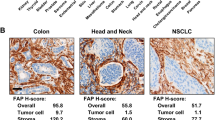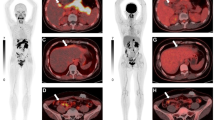Abstract
The goal of this study was to develop a molecular imaging agent that can allow for both positron emission tomography (PET) and near-infrared fluorescence (NIRF) imaging of CD105 expression in metastatic breast cancer. TRC105, a chimeric anti-CD105 monoclonal antibody, was labeled with both a NIRF dye (i.e., IRDye 800CW) and 64Cu to yield 64Cu-NOTA-TRC105-800CW. Flow cytometry analysis revealed no difference in CD105 binding affinity/specificity between TRC105 and NOTA-TRC105-800CW. Serial bioluminescence imaging (BLI) was carried out to non-invasively monitor the lung tumor burden in BALB/c mice, after intravenous injection of firefly luciferase-transfected 4T1 (i.e., fLuc-4T1) murine breast cancer cells to establish the experimental lung metastasis model. Serial PET imaging revealed that fLuc-4T1 lung tumor uptake of 64Cu-NOTA-TRC105-800CW was 11.9 ± 1.2, 13.9 ± 3.9, and 13.4 ± 2.1 %ID/g at 4, 24, and 48 h post-injection respectively (n = 3). Biodistribution studies, blocking fLuc-4T1 lung tumor uptake with excess TRC105, control experiments with 64Cu-NOTA-cetuximab-800CW (which served as an isotype-matched control), ex vivo BLI/PET/NIRF imaging, autoradiography, and histology all confirmed CD105 specificity of 64Cu-NOTA-TRC105-800CW. Successful PET/NIRF imaging of tumor angiogenesis (i.e., CD105 expression) in the breast cancer experimental lung metastasis model warrants further investigation and clinical translation of dual-labeled TRC105-based agents, which can potentially enable early detection of small metastases and image-guided surgery for tumor removal.







Similar content being viewed by others
References
Siegel R, Naishadham D, Jemal A (2012) Cancer statistics, 2012. CA Cancer J Clin 62:10–29
Eckhardt BL, Francis PA, Parker BS, Anderson RL (2012) Strategies for the discovery and development of therapies for metastatic breast cancer. Nat Rev Drug Discov 11:479–497
Weigelt B, Peterse JL, van ‘t Veer LJ (2005) Breast cancer metastasis: markers and models. Nat Rev Cancer 5:591–602
Gambhir SS, Czernin J, Schwimmer J, Silverman DH, Coleman RE, Phelps ME (2001) A tabulated summary of the FDG PET literature. J Nucl Med 42:1S–93S
Alauddin MM (2012) Positron emission tomography (PET) imaging with 18F-based radiotracers. Am J Nucl Med Mol Imaging 2:55–76
Iagaru A (2011) 18F-FDG PET/CT: timing for evaluation of response to therapy remains a clinical challenge. Am J Nucl Med Mol Imaging 1:63–64
Hanahan D, Weinberg RA (2011) Hallmarks of cancer: the next generation. Cell 144:646–674
von Elstermann M (2008) Metastasis: which way to the lungs? Nat Rev Cancer 8:410–411
Ikushima H, Miyazono K (2010) TGFbeta signalling: a complex web in cancer progression. Nat Rev Cancer 10:415–424
Fonsatti E, Nicolay HJ, Altomonte M, Covre A, Maio M (2010) Targeting cancer vasculature via endoglin/CD105: a novel antibody-based diagnostic and therapeutic strategy in solid tumours. Cardiovasc Res 86:12–19
Dallas NA, Samuel S, Xia L, Fan F, Gray MJ, Lim SJ et al (2008) Endoglin (CD105): a marker of tumor vasculature and potential target for therapy. Clin Cancer Res 14:1931–1937
Eary JF, Hawkins DS, Rodler ET, Conrad EU 3rd (2011) 18F-FDG PET in sarcoma treatment response imaging. Am J Nucl Med Mol Imaging 1:47–53
Grassi I, Nanni C, Allegri V, Morigi JJ, Montini GC, Castellucci P et al (2012) The clinical use of PET with 11C-acetate. Am J Nucl Med Mol Imaging 2:33–47
James ML, Gambhir SS (2012) A molecular imaging primer: modalities, imaging agents, and applications. Physiol Rev 92:897–965
Nolting DD, Nickels ML, Guo N, Pham W (2012) Molecular imaging probe development: a chemistry perspective. Am J Nucl Med Mol Imaging 2:273–306
Zhang Y, Hong H, Engle JW, Yang Y, Theuer CP, Barnhart TE et al (2012) Positron emission tomography and optical imaging of tumor CD105 expression with a dual-labeled monoclonal antibody. Mol Pharm 9:645–653
Hong H, Zhang Y, Severin GW, Yang Y, Engle JW, Niu G et al (2012) Multimodality imaging of breast cancer experimental lung metastasis with bioluminescence and a monoclonal antibody dual-labeled with 89Zr and IRDye 800CW. Mol Pharm 9:2339–2349
Zhang Y, Hong H, Severin GW, Engle JW, Yang Y, Goel S et al (2012) ImmunoPET and near-infrared fluorescence imaging of CD105 expression using a monoclonal antibody dual-labeled with 89Zr and IRDye 800CW. Am J Transl Res 4:333–346
Seon BK, Haba A, Matsuno F, Takahashi N, Tsujie M, She X et al (2011) Endoglin-targeted cancer therapy. Curr Drug Deliv 8:135–143
Rosen LS, Hurwitz HI, Wong MK, Goldman J, Mendelson DS, Figg WD et al (2012) A phase I first-in-human study of TRC105 (Anti-Endoglin Antibody) in patients with advanced cancer. Clin Cancer Res 18:4820–4829
Cao Q, Cai W, Niu G, He L, Chen X (2008) Multimodality imaging of IL-18-binding protein-Fc therapy of experimental lung metastasis. Clin Cancer Res 14:6137–6145
Hong H, Severin GW, Yang Y, Engle JW, Zhang Y, Barnhart TE et al (2012) Positron emission tomography imaging of CD105 expression with 89Zr-Df-TRC105. Eur J Nucl Med Mol Imaging 39:138–148
Zhang Y, Hong H, Engle JW, Yang Y, Barnhart TE, Cai W (2012) Positron emission tomography and near-infrared fluorescence imaging of vascular endothelial growth factor with dual-labeled bevacizumab. Am J Nucl Med Mol Imaging 2:1–13
Hong H, Benink HA, Zhang Y, Yang Y, Uyeda HT, Engle JW et al (2011) HaloTag: a novel reporter gene for positron emission tomography. Am J Transl Res 3:392–403
Cai W, Wu Y, Chen K, Cao Q, Tice DA, Chen X (2006) In vitro and in vivo characterization of 64Cu-labeled Abegrin™, a humanized monoclonal antibody against integrin αvβ3. Cancer Res 66:9673–9681
Hong H, Zhang Y, Engle JW, Nayak TR, Theuer CP, Nickles RJ et al (2012) In vivo targeting and positron emission tomography imaging of tumor vasculature with 66Ga-labeled nano-graphene. Biomaterials 33:4147–4156
Hong H, Yang Y, Zhang Y, Engle JW, Barnhart TE, Nickles RJ et al (2011) Positron emission tomography imaging of CD105 expression during tumor angiogenesis. Eur J Nucl Med Mol Imaging 38:1335–1343
Wadas TJ, Wong EH, Weisman GR, Anderson CJ (2010) Coordinating radiometals of copper, gallium, indium, yttrium, and zirconium for PET and SPECT imaging of disease. Chem Rev 110:2858–2902
Dearling JL, Voss SD, Dunning P, Snay E, Fahey F, Smith SV et al (2011) Imaging cancer using PET–the effect of the bifunctional chelator on the biodistribution of a 64Cu-labeled antibody. Nucl Med Biol 38:29–38
Geus-Oei LF, Oyen WJ (2008) Predictive and prognostic value of FDG-PET. Cancer Imaging 8:70–80
Iagaru A, Masamed R, Keesara S, Conti PS (2007) Breast MRI and 18F FDG PET/CT in the management of breast cancer. Ann Nucl Med 21:33–38
van Dongen GA, Vosjan MJ (2010) Immuno-positron emission tomography: shedding light on clinical antibody therapy. Cancer Biother Radiopharm 25:375–385
Wu AM (2009) Antibodies and antimatter: the resurgence of immuno-PET. J Nucl Med 50:2–5
Zhang Y, Hong H, Orbay H, Valdovinos HF, Nayak TR, Theuer CP, et al. (2013) PET imaging of CD105/endoglin expression with a 61/64Cu-labeled Fab antibody fragment. Eur J Nucl Med Mol Imaging (ePub)
Hong H, Zhang Y, Orbay H, Valdovinos HF, Nayak TR, Bean J, et al. (2013) Positron emission tomography imaging of tumor angiogenesis with a 61/64Cu-labeled F(ab’)2 antibody fragment. Mol Pharm (ePub)
Acknowledgments
This work was supported, in part, by the University of Wisconsin Carbone Cancer Center, the Department of Defense (W81XWH-11-1-0644), and the Elsa U. Pardee Foundation. We thank Dr. Xiaoyuan Chen and Dr. Gang Niu for providing the fLuc-4T1 cells.
Author information
Authors and Affiliations
Corresponding author
Rights and permissions
About this article
Cite this article
Zhang, Y., Hong, H., Nayak, T.R. et al. Imaging tumor angiogenesis in breast cancer experimental lung metastasis with positron emission tomography, near-infrared fluorescence, and bioluminescence. Angiogenesis 16, 663–674 (2013). https://doi.org/10.1007/s10456-013-9344-y
Received:
Accepted:
Published:
Issue Date:
DOI: https://doi.org/10.1007/s10456-013-9344-y




